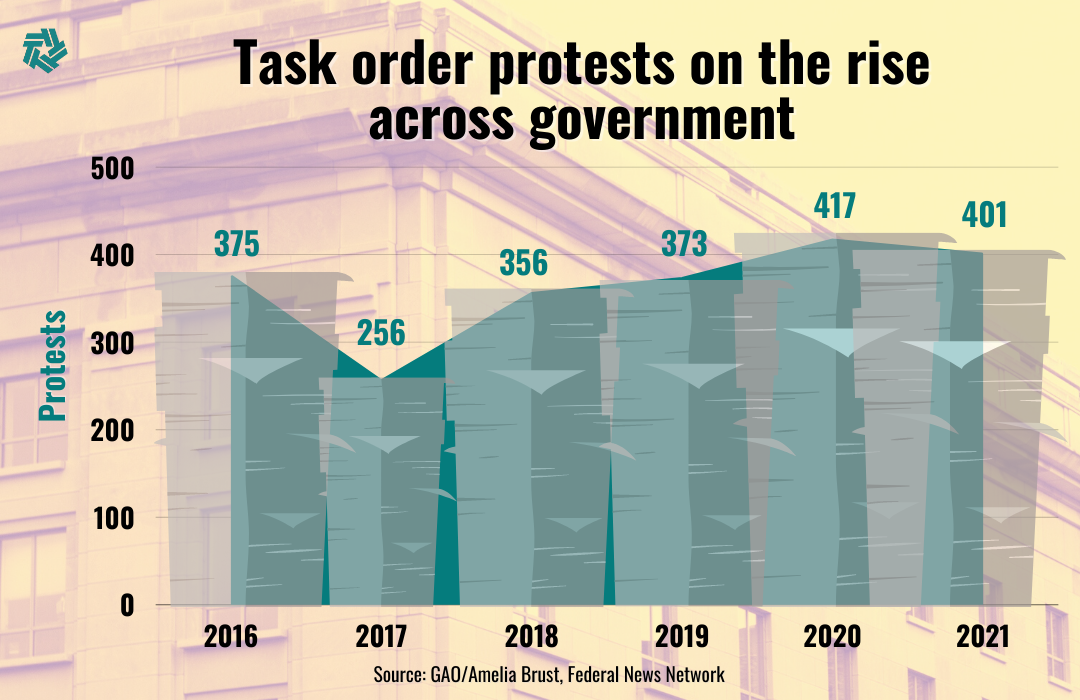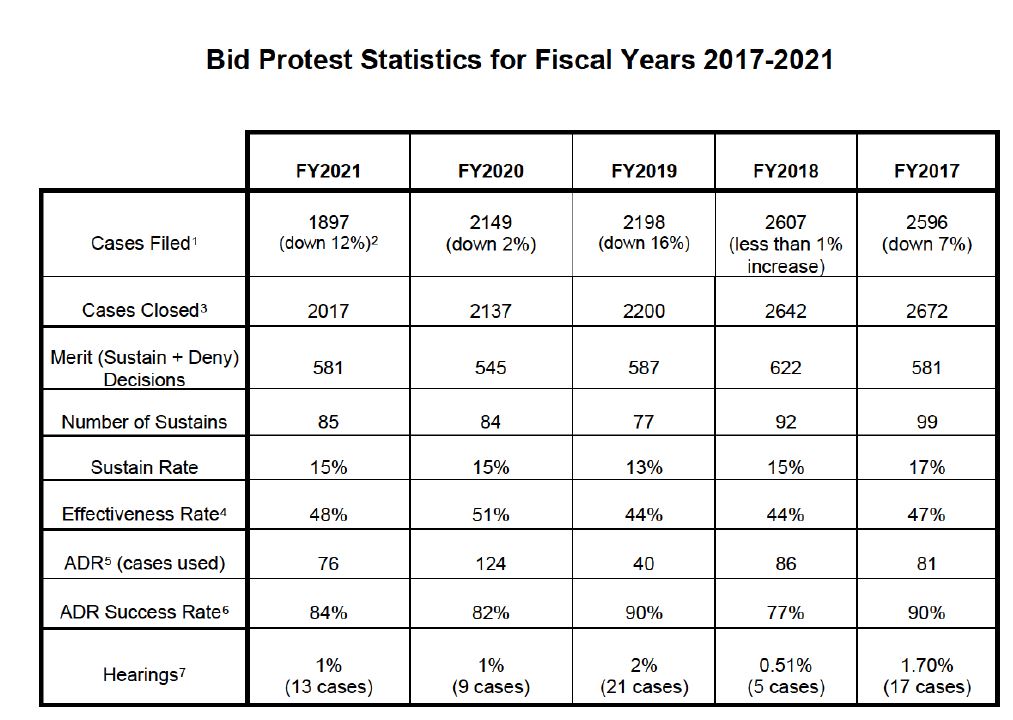Task order protests made up larger percentage of all GAO complaints in 2020
The Government Accountability Office’s annual report to Congress showed vendors filed less than 1,900 protests in fiscal 2020.
Best listening experience is on Chrome, Firefox or Safari. Subscribe to Federal Drive’s daily audio interviews on Apple Podcasts or PodcastOne.
Since Congress approved the ability of vendors to protest task and delivery order contracts in the 2008 National Defense Authorization Act, the federal community has been on edge. Contractors and acquisition professionals alike have expected the number of task order protests to sky rocket and potentially bog down the Government Accountability Office’s system.
While that hasn’t happened in the 13 years since Congress granted this authority, the fiscal 2021 bid protest report to Congress from GAO finally shows a turning tide.
For the first time, the percentage of protests that came from task or delivery order solicitations made up a more significant percentage of the bid protest volume than ever before.
In 2021, GAO said vendors submitted 401 protests from task or delivery order contracts, while the number of protests overall dropped by 12% to 1,897, meaning task and delivery order protests accounted for 21% of all protests. In 2020, for example, task and delivery order protests accounted for 19% of all protests and in 2019, these types of contracts accounted for 17% of all protests.

Emily Murphy, a former administrator of the General Services Administration and senior staff member on the House Armed Services and House Small Business committees, said the increase continues to show the importance of winning these contracts.
“The fact that task and delivery orders were a higher percentage tells me that the amount of money in system wasn’t reason enough for companies not to protest,” said Murphy, who recently joined the George Mason University Center for Government Contracting as a senior fellow. “I think there still is a feeling that if you lost, you want to know why and protesting is one way to find out.”
This increase occurred despite there being fewer large, multiple award task order type of contracts awarded last year.
Barbara Kinosky, the managing partner of Centre Law & Consulting, said despite Congress raising the task and delivery order bid protest threshold to $25 million for Defense Department acquisitions in 2018, the numbers continue to hold steady.
“Even though the number of protests are down 12%, the effectiveness rate is down only 3% so there is an excellent chance for protestors to get some type of relief,” she said.
The effectiveness rate, which was 48% in 2021, is a combination of the number of protests that GAO sustained and the number of protests agencies took corrective action on, meaning that almost half of the time the contractor receives some sort of changes they were looking for in the agency’s decision.
The effectiveness rate jumped to 51% in 2020 — the highest mark ever.
Eric Crusius, a partner with Holland & Knight, said the drop in effectiveness rate but the sustain rate staying the same at 15% means agencies took less corrective action last year.
Crusius, Kinosky and others say this may be related to the drop in total protests because of the increase in the types of contracts agencies used, particularly to meet the needs during the pandemic, that were not protestable such as those under the Defense Production Act or other transaction authorities.
“There was more money in the system last year, and when there is more money in the system, protests historically have gone down,” he said. “There is more for everyone to bid on, there are more task orders too, and both of those are the drivers of lower protests numbers.”

Murphy added another possible reason for a lower number of protests last year was the increased use of enhanced debriefings by DoD and GSA.
Congress mandated DoD provide enhanced debriefings for all awards worth more than $500 million in 2017.
“When we did surveys at GSA, companies told us it was helpful and they were less likely to feel the need to protest if we shared more information,” Murphy said. “If agencies are willing to get into agreements to let lawyers see documents to help vendors know why they lost, there is less of a likelihood of a protest.”
In the 2022 Defense authorization bill, Congress wants DoD to provide them with a briefing on the use and impact of enhanced debriefings by the end of 2021, assuming the bill becomes law.
“The committee is encouraged that in evaluating the extent to which the bid protest system affects or is perceived to affect the quality or quantity of pre-proposal discussions, discussions of proposals or post-award debriefings, the RAND report found that some Department of Defense agencies are improving dialogue with companies to increase the transparency of the procurement process and dissuade unsuccessful offerors from filing bid protests,” the House report stated. “The committee is further encouraged that the enhanced debriefing rights established in section 818 of the National Defense Authorization Act for Fiscal Year 2018 (Public Law 115-91) were immediately implemented as a class deviation and expects the related Defense Federal Acquisition Regulation Supplement case to be resolved soon. In order for the department to gain the full benefit of enhanced debriefings, the committee emphasizes the demonstrated value of meaningful, in-person debriefings to avoid unnecessarily costly and time-consuming bid protests.”
The experts said one of the biggest surprise from the report was the most prominent reasons for vendors to protest.
GAO listed the top four reasons for sustaining protests as
- Unreasonable technical evaluation;
- Flawed discussions;
- Unreasonable cost or price evaluation;
- Unequal treatment
While three of the four are common reasons, the flawed discussions, which generally means the agency engaged in unequal discussions with bidders allowing one vendor to have an advantage over the others, was the rationale that surprised experts.
“It goes to show how careful agencies have to be when engaging with offerors. Discussions are a ripe area for protest and there is a lot of room for second guessing from a disappointed bidder,” Crusius said. “Usually it’s not intentional and the agency thinks they are helping or not doing a good enough job addressing questions from offerors. It can be complicated especially with services.”
Kinosky added, for many years, flawed or unequal discussions was a difficult point to win a protest on because it was a subjective concept.
“It seems now GAO is focusing on making sure these discussions are equal. In some of cases, we are moving more from subjective to objective standard with discussions. The more of an objective line with what is critical and what isn’t and if all critical issues were raised with each party,” she said. “I really believe it’s more of a viable protest ground these days.”
Another trend that may not be clear in the GAO report is what many believe was a disadvantage for incumbent contractors when it came to cost reasonableness.
Kinosky said many contractors believed that the government was hesitant, in some cases, to pay for experienced workers, who tend to cost more.
“I’m seeing this issue that more in high tech issues where there is a shortage of qualified candidates. The government is doing its own evaluation of the market, and it sees a senior engineer would cost ‘X’ amount of money and if a company’s rates or indirect costs will not support that, they are calling it out more,” she said. “The government expects a more robust cost realism analysis because they are interested in ensuring there is low turnover among companies. I think the government is realizing that price isn’t as important in best value when buying high tech services.”
Murphy said one thing to keep in mind when it comes to GAO’s protest report, the fact that there are less than 1,900 protests against tens of thousands of contract actions that happen every year.
“The fact we are talking about a little less than 2,000 protests is remarkable. It’s a really low amount of protests, and it shows the process works well,” she said. “Yes, it can be painful when it doesn’t, but it does work most of the time. I think the low protest rate is good only if we are doing things the right way. If we have a fear of protests and that interferes with the agency’s ability to innovate or not get what they need, then the number is a bad thing.”
Copyright © 2025 Federal News Network. All rights reserved. This website is not intended for users located within the European Economic Area.
Jason Miller is executive editor of Federal News Network and directs news coverage on the people, policy and programs of the federal government.
Follow @jmillerWFED






